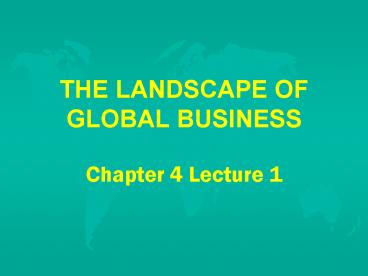THE LANDSCAPE OF GLOBAL BUSINESS Chapter 4 Lecture 1 PowerPoint PPT Presentation
1 / 12
Title: THE LANDSCAPE OF GLOBAL BUSINESS Chapter 4 Lecture 1
1
THE LANDSCAPE OF GLOBAL BUSINESS Chapter 4
Lecture 1
2
Why are Global Businesses Important to Us
- Economy is about 40 trillion
- 2003 Snapshot of the Global 500
- 13.729 trillion in revenues
- Businesses will employ many of you
- You doubtless want to work for a good business
3
What are Business Categories of Global
Enterprises?
- Global Giants
- Public ownership
- Private ownership
- Small to medium size firms
- Family owned
- Public ownership
- Global Start-ups
- (Other global enterprises include global
nongovernmental organizations, intergovernmental
organizations, and global gangs or terrorist
groups)
4
Global Giants
- Global Brand giantscan be public or private, but
due to brand awareness, they usually are fairly
well monitored by the press - These are many of the firms we are studyingcheck
Interbrand or AC Nielsen for ratings - Usually are from advanced economies, but
developing economies are trying to buy or build
global brands, e.g., Haier - Hidden giantscompanies whose activities are not
in the public eye, e.g., cement, building
materials, insurance companies, food production,
machinerywe also study these because life is not
all brand glamour - Some are not in the public eye because we dont
care - Some are not in the public eye because the parent
company does not want us to know - Ben and Jerrys is owned by Unilever
- Coca-Cola owns Odwalla
- General Mills owns Small Planet Foods
5
Note from SAGE is this image integral?
6
Here are Global Firms, Who Owns Them?
- B. Husky Energy
- E. Euro-Disney
- F. Johnnie Walker Scotch Whisky
- G. Gerber Baby Foods
- J. All-Clad Metalcrafters
- K. VP Schickedanz
7
Small to Medium Size Companies
- The definition of what constitutes small and
medium size varies (making it hard to compare
worldwide) - Also can create a global brand (but usually a
single brand in a single industry, e.g., Dr
Martens) - Also can be hidden champions
- Can be a global start-up
- Logitechfounded by people from different
countries, headquartered in two nations, to serve
a global market - Often depend on entrepreneurial behaviors
8
Brands and Society
- Brands satisfy human needs for belonging and
satisfaction - In nations where standards are low, brands
provide assurance of product quality - Brands also raise public awareness about firm
behavior and mediating organizations motivate
many - To pursue social and environmental responsibility
within the firminternal adaptation mediated by
NGOs like Greenpeace - To address issues that occur outside the
firmexternal adaptations that make firms
mediators for others even as others mediate these
issues for them - Suppliers treatment of employees or ways they
extract raw materials - Some go on the defensive
- Some focus on values and proactive efforts
9
The Bottom Line on Global Firms
- Whether large, medium or small
- Whether public or privately owned by families or
by shareholders or by the government, etc. - All contribute to and are challenged by
characteristics of globalization.
10
Among Challenges Relevant to Your Studies,
Consider the Effects of
- Diverse participants in the industry studied
- Stakeholder and owner activism
- Individuals and institutional
- Competing models of how to manage globally
- The Anglo Saxon model is more hands off and
encourages shorter run profit motives - The Rhine model is cooperative and encourages
more social engagement for firms
11
We do Not Know the Outcomes, but We do Know
- These challenges are altering firm management
such that nations are adopting practices from
other settings - Asian collectivism accommodates revised social
contracts, e.g., layoffs - Anglo Saxon traditions are revised to separate
the CEO from the Board - The Rhine model experiences pressures to generate
shorter term profits
12
As a General Statement We Can Say
- Corporations worldwide are under pressure to
consider themselves - Members of a dynamic community
- Linked by networks of interdependent teams
- Composed of self-managing people with diverse
characteristics and talents - Guided by shared purpose
- Leaders committed to continuous learning and
improvement - In service to maximum long-term customer
satisfaction, employee and shareholder
enrichment, and the health of the larger society

